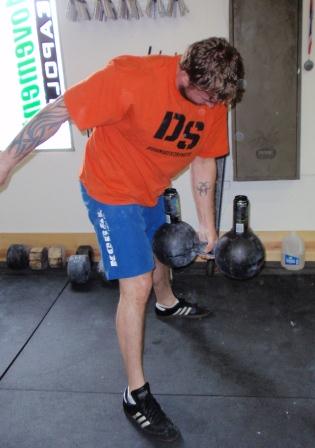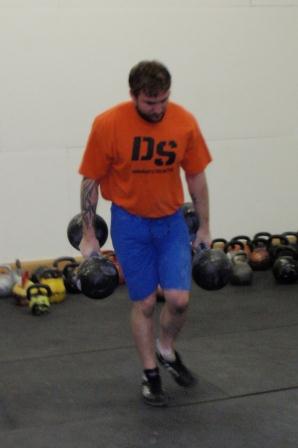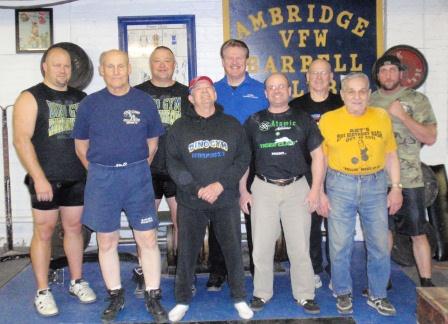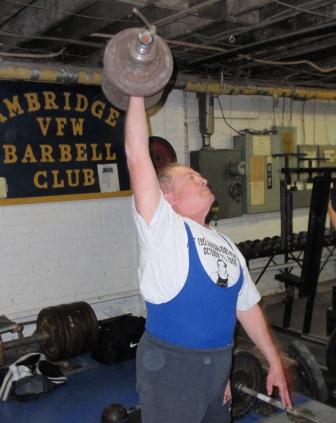One Hand Swing
by Roger LaPointe
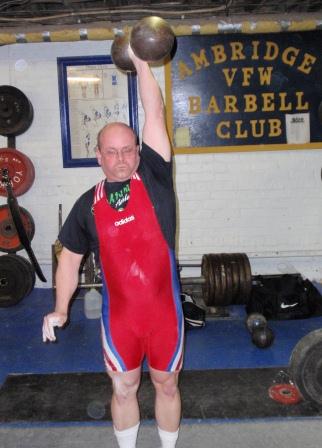
Roger LaPointe, of Atomic Athletic, performing a dumbbell swing with an "old school" Jackson 80# globe dumbbell at the Ambridge Barbell Club.
Quick lifts seem to be all the rage right now, for good reason.
The One Hand Dumbbell Swing is one explosive lift you do not see a lot of, but you are really missing out if you aren’t doing it. It was one of the contest lifts in Ambridge, PA last weekend, at the Ambridge Barbell Club USAWA (All-Round) weightlifting meet.
First of all, the guys in that organization are a treasure trove of information. I had been casually training the lift for about a month. The deeper I looked at it and experimented with it, the more interesting it became. As with many All-Round Association events, I came out of the meet with a far greater understanding of the lift than when I went in. You may have noticed, that I tend to repeat lifts from one meet to the next. The idea is that in a 6 month period of time, you can then have two contests where you can show some improvement from the first to the second.
EQUIPMENT
To start with, you want to lift on the most appropriate equipment. It doesn’t have to be the most expensive, but there are certain key factors to consider. Now, my favorite dumbbell at the meet was the one I used for my final attempt, which was a good one. However, if I were trying to set a record, or push my absolute limit, I would NOT have used that dumbbell. I like that dumbbell because it was an antique Jackson solid, globe head, dumbbell. It was down right cool. Yet, the grip area was much too long and unknurled.
Ideally, you want a rotating Olympic sized plate loading dumbbell with a handle that is similar diameter to an Olympic barbell. I have one in my collection that measures 1 1/4 inches in diameter and it is simply too big. The goal of a swing is not just to work your grip. A swing should be a test of your back, hips and traps. You also need to have very solid collars. There is no way I would trust little spring collars or something made of plastic. I use leather lined Spin-Lock Collars that you can crank down on.
TECHNIQUE
1. Make sure you get a good grip. I also like to have the thumb side of my hand cranked in tight to the inside collar.
2. Don’t do too many swings, three should be enough. More than that and you are wasting energy and explosiveness. With your final swing you want to go up more than out with a genuine triple extension.
3. Don’t forget you can also drop under it and catch it in a split. There will be more looping of the dumbbell than in a snatch, so you will want to practice the split. You could could catch it in a quarter squat type movement, but you will probably have to jump backward to receive the dumbbell. That is possibly stronger, but chancy. I started off using that method, because of my Olympic lifting background. While that swing split is certainly different from a barbell jerk split, I am gradually switching and adapting to it.
4. Finally, lock your shoulder right into the side of your head. There is a really cool screw type motion that makes it stunningly solid.
Finally, if you are not already doing full barbell Olympic weightlifting, then start. The application of that type of training to the One Hand Dumbbell Swing is so obvious as to not even warrant discussion.
Have fun. Today is a good day to lift. Live strong.
